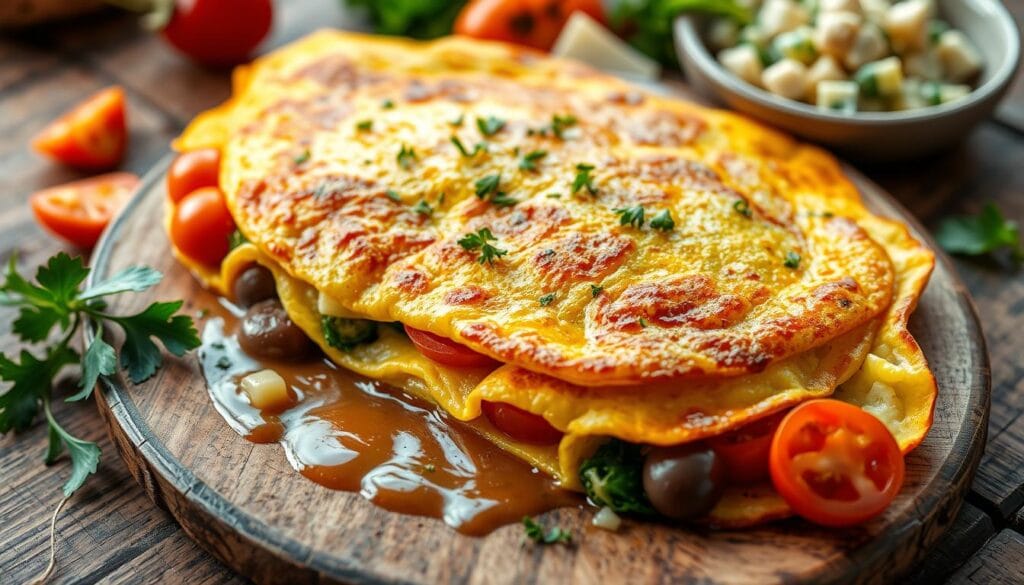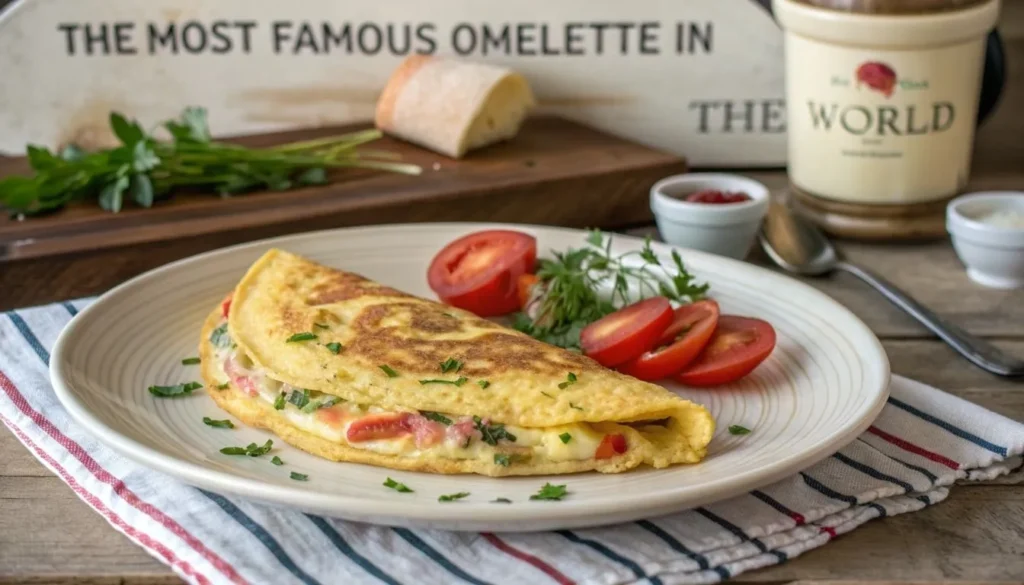
What is the most famous omelette in the world? The soufflé omelette from La Mère Poulard in Mont Saint Michel, France, takes this title. For over a century, it has amazed tourists with its unique cooking method and light, airy texture.
This dish was created to feed visitors quickly between tides. It’s a simple yet innovative way to serve guests at the famous Abbey.
Table of contents
The Legacy of La Mère Poulard’s Soufflé Omelette: The Most Famous Omelette in the World
In the beautiful commune of Mont Saint Michel, La Mère Poulard and her soufflé omelette are a big deal. This dish, made famous by “La Mère Poulard,” has won over visitors for over a hundred years.
The History Behind Mont Saint Michel’s Culinary Icon
The story of the La Mère Poulard omelette starts in the late 1800s. Annette Poulard, known as “La Mère Poulard,” opened a small inn on Mont Saint Michel. People came from everywhere to try her famous soufflé omelette.
Why Tourists Flocked to Taste This Legendary Dish
The La Mère Poulard omelette was special because of its light and fluffy texture. Chefs made it in copper pots, beating the eggs hard. This made the dish a must-see for anyone visiting Mont Saint Michel.
The Original Recipe’s Secret Components
The secret to the La Mère Poulard omelette’s greatness is in its cooking method. It’s made in a special pan over a wood fire, with lots of air beaten into the eggs. These old ways have kept the omelette famous in French cuisine.

What Makes the Most Famous Omelette in the World Special?
The French omelette is known as the most famous omelette globally. It’s famous for its simple yet challenging nature, seen as a chef’s ultimate test. The perfect French omelette has a pale yellow, smooth outside and a tender, creamy inside. It’s a dish that fits any meal time.
This omelette is a perfect example of minimalism in cooking. Made with just eggs, butter, and a bit of seasoning, it highlights the quality of its ingredients. It’s a favorite in fancy restaurants and home kitchens, often served with a salad and wine for a fancy meal.
“The French omelette is a true culinary masterpiece, a testament to the power of simplicity and the importance of technique.”
Though it looks simple, making the perfect French omelette is an art. It needs a gentle touch and a deep understanding of egg proteins. The secret to its texture is in controlling temperature and timing, and using copper pans. Learning to make a French omelette is a big step for chefs, and it’s a dish that fascinates food lovers everywhere.
Whether you’re an experienced cook or just starting, mastering the French omelette is worth it. Its timeless appeal and lasting popularity make it the most famous omelette globally. It’s a true culinary icon that will keep inspiring and pleasing people for years to come.
The Art of French Omelette Making: Creating the Most Famous Omelette in the World
Learning to make a French omelette is a skill many love. It’s all about getting the texture, temperature, and timing just right. This turns a simple egg into a delicious treat.
Essential Techniques for Perfect Texture
Beating the eggs well is key to a great French omelette. Whisk them hard for at least 30 seconds. This makes sure the eggs are smooth and fluffy.
Temperature Control and Timing
After beating the eggs, controlling the heat and timing is important. Cook the omelette on medium-low heat. This helps it cook evenly and quickly, in about 3 minutes.
The Role of Traditional Copper Cookware
Copper pans are a favorite for making omelettes. They heat evenly, so the eggs cook perfectly. Beating eggs in a copper bowl also helps keep the temperature right.
| Key Factors for a Perfect French Omelette | Recommended Techniques |
|---|---|
| Egg Ratio | 3 large eggs per omelette |
| Whisking Time | At least 30 seconds to fully incorporate whites and yolks |
| Butter Amount | 1 tablespoon for a 3-egg omelette |
| Pan Type | Nonstick pan |
| Heat Level | Medium-low to avoid sizzling |
| Cooking Duration | Less than 5 minutes from start to finish |
With these tips and the help of chefs like Julia Child and Jacques Pépin, you can make a great French omelette. It will make your breakfast or brunch even better.
Key Ingredients That Define the Most Famous Omelette in the World
The secret to a great omelette is in its ingredients. To make a famous omelette, use the freshest omelette ingredients. This includes:
- Eggs: The base of any omelette, high-quality eggs are key. Choose large, farm-fresh eggs for the best taste and texture.
- Butter: A bit of salted butter makes the omelette rich and perfect.
- Fresh Herbs: Chopped fresh herbs like chives, parsley, tarragon, or chervil add flavor and aroma.
While the basic ingredients are simple, their quality matters a lot. Don’t skimp on these essentials, as they make a memorable omelette. You can also add seasonal veggies, crispy bacon, sautéed scallops, or smoked salmon for extra taste.
| Ingredient | Quantity | Description |
|---|---|---|
| Eggs | 2-3 large | Fresh, high-quality eggs for the best texture and flavor |
| Butter | 1-2 tbsp | Salted butter to add richness and help achieve the perfect omelette texture |
| Fresh Herbs | 2-3 tbsp, chopped | Chives, parsley, tarragon, or chervil for a burst of flavor and aroma |
By using these top-notch, basic omelette ingredients, you’re on your way to making a world-class omelette. It will impress your taste buds and leave a memorable mark.
Traditional French Omelette vs Modern Variations: Understanding the Most Famous Omelette in the World
The traditional French omelette is a beloved dish worldwide. It’s known for its simplicity and focus on egg flavors. Cooked quickly, it has a soft, silky texture and minimal fillings.
Today, omelettes have evolved with many variations. These new styles use local ingredients and cooking methods. For example, the Spanish “Tortilla Española” and the Japanese omelette are just a few examples.
Classic French Preparation Methods
The traditional French omelette is all about simplicity. Eggs are cooked fast over high heat. This makes the inside soft and the outside slightly browned.
Contemporary Adaptations Worldwide
Omelettes have changed a lot as they traveled the world. The Spanish “Tortilla Española” is a thick, cake-like omelette. In Japan, omelettes are made with sugar, water, and rice vinegar for a sweet-and-savory taste.
Regional Influences on Omelette Making
Omelettes vary greatly around the world. In India, they’re flavored with ginger. In the US, they’re often filled with cheese. The Welsh omelette is different from others, showing the diversity of omelette-making.
The omelette has come a long way from its French roots. Today, it’s enjoyed in many forms worldwide. Whether you like the classic French style or want to try something new, omelettes offer a world of flavors.
Expert Tips for Creating Restaurant-Quality Omelettes
Want to make omelettes like a pro? Follow these expert tips to get that restaurant-quality texture. Chefs like Gordon Ramsay have mastered omelette making. Their techniques will help you make perfect breakfast or brunch dishes at home.
First, choose the right tools. Get a high-quality nonstick pan and a silicone spatula. These tools will help you fold and slide the omelette smoothly. Make sure to beat the eggs well to get a light, fluffy texture.
Temperature control is key. Start with medium-low heat and avoid high heat. This slow cooking ensures an evenly cooked omelette. Remember, folding the omelette gently is important for those soft, creamy folds.
Practice makes perfect. As Gordon Ramsay says, “The more you cook, the better you get.” Don’t worry if your first tries aren’t perfect. With time and focus, you’ll soon be making restaurant-quality omelettes.
| Omelette Tip | Explanation |
|---|---|
| Use the Right Tools | Invest in a high-quality nonstick pan and a silicone spatula for easy folding and sliding. |
| Beat the Eggs Thoroughly | Incorporate air into the eggs for a light, fluffy texture. |
| Control the Heat | Start with a medium-low heat setting and avoid high heat for even cooking. |
| Master the Folding Technique | Gently fold the omelette over itself to create signature soft, creamy folds. |
| Practice, Practice, Practice | The more you cook, the better you’ll get at making restaurant-quality omelettes. |
The Science Behind Perfect Omelette Texture
The secret to achieving the soft texture of a famous omelette in the world is understanding how egg proteins coagulate under heat and incorporating air during whisking.
Understanding Egg Protein Structure
Eggs are mostly water and proteins, which are key to the omelette’s feel. Beating eggs vigorously breaks down these proteins. This makes the omelette smooth and soft.
The Impact of Heat Distribution
Heat plays a big role in how the omelette turns out. Even heat helps proteins cook right, making the inside creamy and the outside smooth. Too much heat or uneven cooking can make the omelette tough or dry. It’s all about finding the right balance.
“The perfect omelette is a balance of art and science, where the interplay of egg proteins and heat transform a simple dish into a culinary masterpiece.”
Knowing about egg protein structure and heat distribution in cooking helps you make perfect omelettes. These dishes are silky smooth and full of flavor.
Popular Omelette Garnishes and Accompaniments
Fresh herbs, sautéed vegetables, or smoked salmon are often used to enhance the flavors of a famous omelette in the world, offering variety while complementing its simplicity.
Fresh herbs like chives, parsley, or tarragon are a popular choice. They add a burst of freshness that pairs well with the eggs. Cheese, from tangy blue cheese to nutty Fourme d’Ambert, is also a favorite.
Adding sautéed vegetables like mushrooms, tomatoes, or spinach can make your omelette more filling. Crispy bacon or seared scallops add savory notes and a touch of luxury.
The choice of garnishes and sides often depends on where you are and the season. By trying different combinations, you can find the perfect mix of flavors to take your omelette to the next level.
| Omelette Garnish | Flavor Profile | Complementary Ingredients |
|---|---|---|
| Fresh Herbs (Chives, Parsley, Tarragon) | Bright, Aromatic | Eggs, Cheese, Sautéed Vegetables |
| Creamy Blue Cheese | Tangy, Savory | Eggs, Caramelized Onions, Roasted Tomatoes |
| Sautéed Potatoes | Crispy, Hearty | Eggs, Bacon, Chives |
| Smoked Salmon | Salty, Briny | Eggs, Dill, Crème Fraîche |
Remember, the secret to a great omelette is to try different garnishes and sides. This way, you can find what you like best and use seasonal ingredients. By exploring, you’ll become a pro at making omelettes.
Common Mistakes to Avoid When Replicating a Famous Omelette in the World
Overcooking or overfilling are mistakes that can ruin a dish like the most famous omelette in the world. Master the basics for better results.
- Overcooking the Eggs – Overcooked eggs become dry and rubbery. Watch the cooking time and temperature closely. The USDA says eggs are safe for 3 to 5 weeks in the fridge.
- Using the Wrong Pan – Use an 8-inch nonstick pan, as chef Jacques Pépin suggests for a 3-egg omelette. The wrong pan or bad heat control can cause uneven cooking or burning.
- Insufficient Egg Beating – Not beating eggs enough can leave white streaks. This affects the omelette’s look and feel. Aim for 2 to 3 eggs for the best result.
- Overfilling the Omelette – Too many ingredients make folding hard and mess with flavors. Use less than ½ cup of veggies to keep things balanced.
Mastering these techniques will help you make perfect gourmet omelettes. The secret is in the right cooking time, temperature, and gentle folding.
| Common Omelette Mistakes | Recommended Solutions |
|---|---|
| Overcooking the Eggs | Monitor cooking time and temperature to avoid a dry, rubbery texture |
| Using the Wrong Pan | Opt for an 8-inch nonstick pan for optimal heat distribution and cooking |
| Insufficient Egg Beating | Thoroughly beat the eggs to ensure a smooth, uniform texture |
| Overfilling the Omelette | Limit ingredients to under ½ cup of vegetables for a balanced flavor |
Avoid these omelette mistakes and cooking errors to master omelette making. You’ll soon be making gourmet omelettes like a pro at home.
FAQs:
1. What does Gordon Ramsay put in his omelette?
Fresh eggs, butter, crème fraîche, salt, pepper, and herbs like chives.
2. Which is the best omelette?
La Mère Poulard’s soufflé omelette and the classic French omelette are top favorites.
3. Why are IHOP omelettes so fluffy?
They add pancake batter to the eggs for extra fluffiness and tenderness.
4. What is the most famous omelette in France?
La Mère Poulard’s soufflé omelette from Mont Saint Michel.
5. Which country is famous for omelette?
France, for its classic and soufflé-style omelettes.
Conclusion: Celebrating the Famous Omelette in the World and Its Legacy
The world of famous omelettes shows how much skill goes into making simple dishes great. La Mère Poulard’s soufflé omelette and the classic French omelette are just a few examples. These dishes have become famous around the world.
Learning how to make the perfect omelette is a journey worth taking. It can make you a better cook, whether you’re a pro or just starting out. By mastering the art of omelette making, you can make dishes that taste like they came from a restaurant.
Exploring different omelettes can also teach you about different cultures. You’ll learn about the ingredients and techniques used in each dish. This can make you appreciate omelettes even more.
Don’t be afraid to try new things with your omelettes. Add different garnishes or try omelettes from different places. This way, you can find the perfect omelette for your taste.
By diving into the world of omelettes, you’ll not only impress your friends and family. You’ll also grow to love making omelettes even more. It’s a journey that combines skill, creativity, and delicious food.
